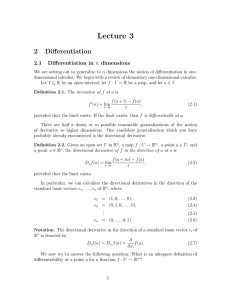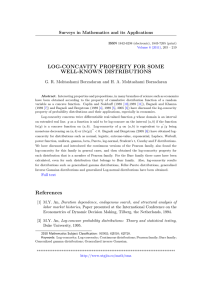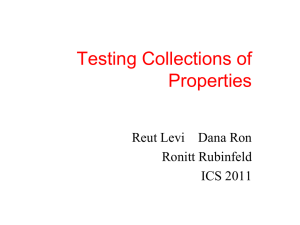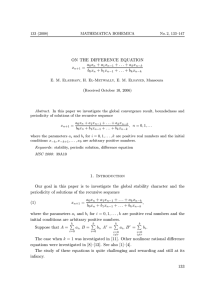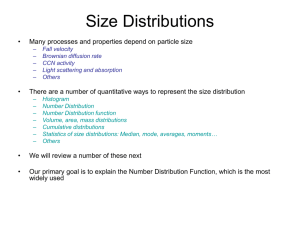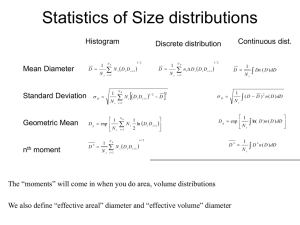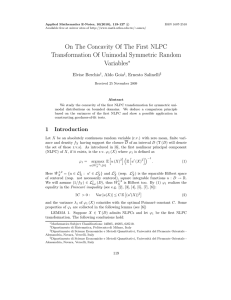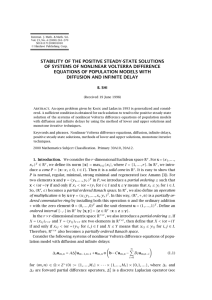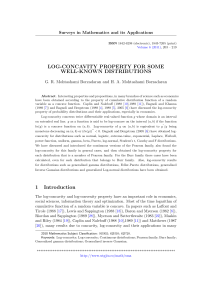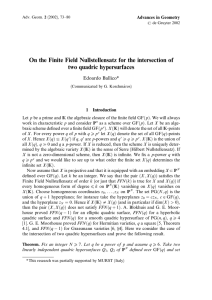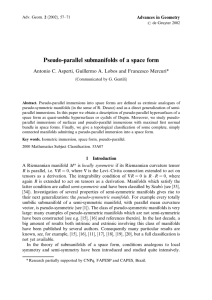THE SEQUENTIAL APPROACH TO THE PRODUCT OF DISTRIBUTION C. K. LI
advertisement
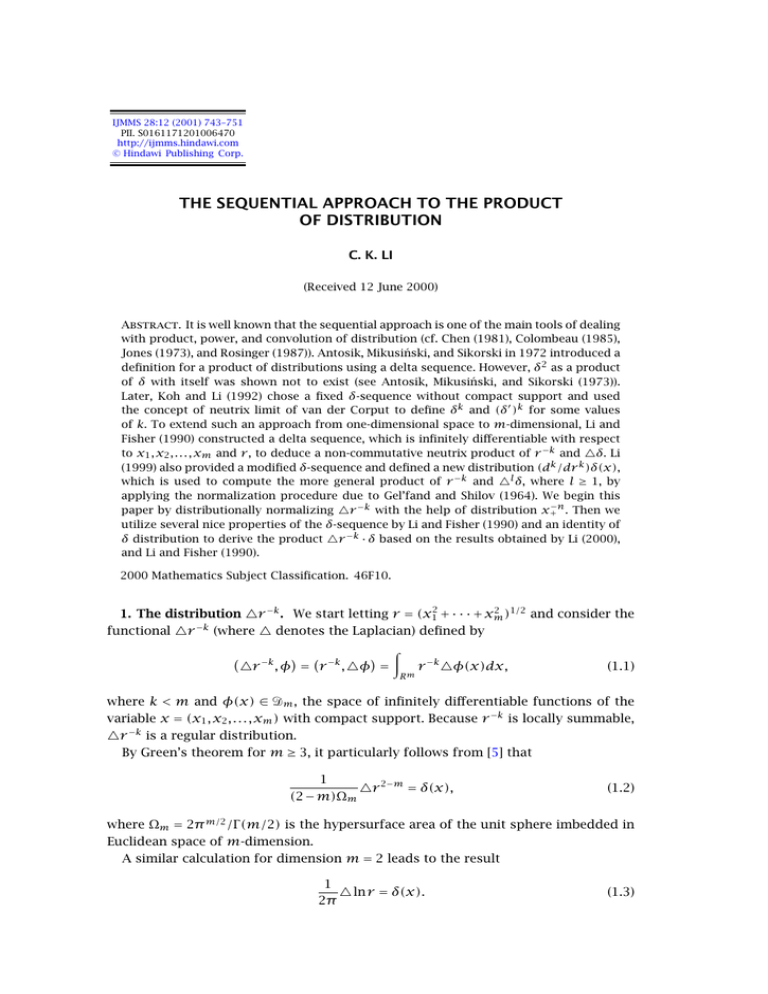
IJMMS 28:12 (2001) 743–751
PII. S0161171201006470
http://ijmms.hindawi.com
© Hindawi Publishing Corp.
THE SEQUENTIAL APPROACH TO THE PRODUCT
OF DISTRIBUTION
C. K. LI
(Received 12 June 2000)
Abstract. It is well known that the sequential approach is one of the main tools of dealing
with product, power, and convolution of distribution (cf. Chen (1981), Colombeau (1985),
Jones (1973), and Rosinger (1987)). Antosik, Mikusiński, and Sikorski in 1972 introduced a
definition for a product of distributions using a delta sequence. However, δ2 as a product
of δ with itself was shown not to exist (see Antosik, Mikusiński, and Sikorski (1973)).
Later, Koh and Li (1992) chose a fixed δ-sequence without compact support and used
the concept of neutrix limit of van der Corput to define δk and (δ )k for some values
of k. To extend such an approach from one-dimensional space to m-dimensional, Li and
Fisher (1990) constructed a delta sequence, which is infinitely differentiable with respect
to x1 , x2 , . . . , xm and r , to deduce a non-commutative neutrix product of r −k and δ. Li
(1999) also provided a modified δ-sequence and defined a new distribution (dk /dr k )δ(x),
which is used to compute the more general product of r −k and l δ, where l ≥ 1, by
applying the normalization procedure due to Gel’fand and Shilov (1964). We begin this
−n
. Then we
paper by distributionally normalizing r −k with the help of distribution x+
utilize several nice properties of the δ-sequence by Li and Fisher (1990) and an identity of
δ distribution to derive the product r −k · δ based on the results obtained by Li (2000),
and Li and Fisher (1990).
2000 Mathematics Subject Classification. 46F10.
2 1/2
1. The distribution r −k . We start letting r = (x12 + · · · + xm
)
and consider the
−k
(where denotes the Laplacian) defined by
functional r
r −k , φ = r −k , φ =
Rm
r −k φ(x)dx,
(1.1)
where k < m and φ(x) ∈ Ᏸm , the space of infinitely differentiable functions of the
variable x = (x1 , x2 , . . . , xm ) with compact support. Because r −k is locally summable,
r −k is a regular distribution.
By Green’s theorem for m ≥ 3, it particularly follows from [5] that
1
r 2−m = δ(x),
(2 − m)Ωm
(1.2)
where Ωm = 2π m/2 /Γ (m/2) is the hypersurface area of the unit sphere imbedded in
Euclidean space of m-dimension.
A similar calculation for dimension m = 2 leads to the result
1
ln r = δ(x).
2π
(1.3)
744
C. K. LI
On making substitution of spherical coordinates in (1.1), we come to
∞
r −k
φ(ω)dω r m−1 dr ,
r −k , φ =
r =1
0
(1.4)
where dω is the hypersurface element on the unit sphere. The integral appearing in
the above integrand can be written in the form
φ(ω)dω = Ωm Sφ (r ),
(1.5)
r =1
where Sφ (r ) is the mean value of φ on the sphere of radius r .
It could be proved by the well-known Pizetti’s formula in [4] that Sφ (r ) is infinitely
differentiable for r ≥ 0, has bounded support, and that
Sφ (r ) = φ(0) +
=
1 1
(2k)
S (0)r 2 + · · · +
S
(0)r 2k + · · ·
2! φ
(2k)! φ
(1.6)
∞
k+1 φ(0)r 2k
.
k
2 k!m(m + 2) · · · (m + 2k − 2)
k=0
Note that when k = 0, the first term of the above series is defined as φ(0).
From (1.4) and (1.5), we obtain
∞
r −k+m−1 Sφ (r )dr
r −k , φ = Ωm
0
1
= Ωm
r −k+m−1 Sφ (r )dr + Ωm
0
∞
1
r −k+m−1 Sφ (r )dr
(1.7)
= I 1 + I2 .
It obviously follows that
I2 = Ωm
∞
1
r −k+m−1 Sφ (r )dr
(1.8)
is well defined for any positive integer k.
In order to normalize I1 for k ≥ m, we need the following equation (see [6]):
n−1
−n
,φ =
x[0,1]
φ(j−1) (0)
(j − 1)!(−n + j)
j=1
1
x n−1
φ(n−1) (0) dx,
+ x −n φ(x) − φ(0) − xφ (0) − · · · −
(n − 1)!
0
(1.9)
where n ≥ 1.
Setting n = 1, 2 in (1.9), we have
1
−1
,φ =
x −1 φ(x) − φ(0) dx,
x[0,1]
0
1
−2
x[0,1]
, φ = −φ(0) + x −2 φ(x) − φ(0) − xφ (0) dx,
0
respectively.
(1.10)
THE SEQUENTIAL APPROACH TO THE PRODUCT OF DISTRIBUTION
745
Using (1.9), we normalize I1 for k ≥ m by
1
I 1 = Ωm
= Ωm
0
r −k+m−1 Sφ (r )dr
(j−1)
k−m
j=1
Sφ (0)
(j − 1)!(−k + m − 1 + j)
1
r −k+m−1 Sφ (r ) − Sφ (0) − r Sφ
(0)
+ Ωm
0
−···−
(1.11)
r k−m
(k−m)
Sφ (0) dr .
(k − m)!
In particular for k = m, we obtain
r −m , φ = Ωm
1
0
∞
r −1 Sφ (r ) − Sφ (0) dr + Ωm
r −1 Sφ (r )dr .
(1.12)
1
2. The product r −k · l δ. The following δ-sequence was used by Fisher around
1969. Let ρ(x) be a fixed infinitely differentiable function defined on R with the following properties:
(i) ρ(x) ≥ 0,
(ii) ρ(x) = 0 for |x| ≥ 1,
(iii) ρ(x) = ρ(−x),
1
(iv) −1 ρ(x)dx = 1.
The function δn (x) is defined by δn (x) = nρ(nx) for n = 1, 2, . . . . It follows that
{δn (x)} is a regular sequence of infinitely differentiable functions converging to the
Dirac delta-function δ(x).
Now let Ᏸ be the space of infinitely differentiable functions of a single variable with
compact support and let Ᏸ be the space of distributions defined on Ᏸ. Then if f is
an arbitrary distribution in Ᏸ , we define
fn (x) = f ∗ δn (x) = f (t), δn (x − t)
(2.1)
for n = 1, 2, . . . . It follows that {fn (x)} is a regular sequence of infinitely differentiable
functions converging to the distribution f (x) in Ᏸ .
The following definition for the non-commutative neutrix product f · g of two distributions f and g in Ᏸ was given by Fisher in [1].
Definition 2.1. Let f and g be distributions in Ᏸ and let gn = g ∗δn . We say that
the neutrix product f · g of f and g exists and is equal to h if
N- lim f gn , φ = (h, φ)
n→∞
(2.2)
for all functions φ in Ᏸ, where N is the neutrix (see [9]) having domain N = {1, 2, . . .}
and range N , the real numbers, with negligible functions that are finite linear sums
of the functions
nλ lnr −1 n,
lnr n
(λ > 0, r = 1, 2, . . .)
(2.3)
746
C. K. LI
and all functions of n which converge to zero in the normal sense as n tends to
infinity.
With Definition 2.1, a lot of products of distributions have been computed by Fisher
and Al-Sirehy (see [1, 2]), such as
λ
−λ−r
λ
−λ−r
x+
· x−
= (−1)r −1 x−
· x+
=−
(x + i0)λ · (x + i0)−λ−r = x −r +
π csc(π λ) (r −1)
δ
(x),
2(r − 1)!
(−1)r iπ (r −1)
δ
(x) = (x + i0)−r ,
(r − 1)!
(2.4)
|x|λ · |x|−λ−2r = x −2r ,
for a noninteger λ and r = 1, 2, . . . .
Remark 2.2. The product of Definition 2.1 is not symmetric and hence f ·g ≠ g ·f
in general. Furthermore, it is nonassociative since
x −1 · x · δ(x) = 1 · δ(x) = δ(x) = 0 = x −1 · 0 = x −1 · x · δ(x) .
(2.5)
In order to give a definition for a neutrix product f · g of two distributions in Ᏸm ,
the space of distributions defined Ᏸm . We may attempt to define a δ-sequence in Ᏸm
by simply putting (see [3])
δn x1 , . . . , xm = δn x1 · · · δn xm ,
(2.6)
where δn is defined as above. However, this definition is very difficult to use for distributions in Ᏸm which are functions of r . We therefore consider the following approach
(see [8]).
Let ρ(s) be a fixed infinitely differentiable function defined on R+ = [0, ∞) having
the following properties:
(i) ρ(s) ≥ 0,
(ii) ρ(s) = 0 for s ≥ 1,
(iii) Rm δn (x)dx = 1,
where δn (x) = cm nm ρ(n2 r 2 ) and cm is the constant satisfying (iii).
It follows that {δn (x)} is a regular δ-sequence of infinitely differentiable functions
converging to δ(x) in Ᏸm .
Definition 2.3. Let f and g be distributions in Ᏸm and let
gn (x) = g ∗ δn (x) = g(x − t), δn (t) ,
(2.7)
where t = (t1 , t2 , . . . , tm ). We say that the neutrix product f · g of f and g exists and
is equal to h if
(2.8)
N- lim f gn , φ = (h, φ),
n→∞
where φ ∈ Ᏸm and the N-limit is defined as above.
THE SEQUENTIAL APPROACH TO THE PRODUCT OF DISTRIBUTION
747
By Definition 2.3, Li and Fisher [6, 8] showed that the noncommutative neutrix product r −k · l δ exists and
l!
l+k δ,
2k (l + k)!(m + 2l)(m + 2l + 2) · · · (m + 2l + 2k − 2)
r −2k · l δ =
(2.9)
r 1−2k · l δ = 0,
where k and l are nonnegative integers.
It immediately follows from l = 0, 1 that
r −2k · δ =
k δ
2k k!m(m + 2) · · · (m + 2k − 2)
,
(2.10)
r 1−2k · δ = 0,
r −2k · δ =
r
1−2k
1+k δ
,
2k (k + 1)!(m + 2)(m + 4) · · · (m + 2k)
(2.11)
· δ = 0.
3. Main results. The following two lemmas will play an important role in obtaining
the product r −k · δ as well as others.
Lemma 3.1. Let Di = ∂/∂xi . Then for k ≥ 0,
m
m
k xi Di φ = 2kk φ +
xi Di k φ ,
i=1
(3.1)
i=1
where φ ∈ Ᏸm .
Proof. We use an inductive method to show the lemma. It is obviously true for
k = 0. Assuming k = 1, we have
∂2
xi Di φ = 2 2 φ + xi Di (φ)
∂xi
(3.2)
simply by calculating the left-hand side. As for the sum,
m
i=1
m
xi Di φ = 2φ +
xi Di (φ).
(3.3)
i=1
By the inductive hypothesis, equation (3.1) holds for the case of k − 1, that is,
m
i=1
m
xi Di k−1 φ .
k−1 xi Di φ = 2(k − 1)k−1 φ +
i=1
(3.4)
748
C. K. LI
Hence, it follows that
m
m
m
k xi Di φ = k−1 xi Di φ = 2(k − 1)k−1 φ +
xi Di k−1 φ
i=1
i=1
i=1
= 2(k − 1)k φ +
m
xi Di k−1 φ
i=1
= 2(k − 1)k φ +
m 2
i=1
k ∂2
k−1
φ
+
x
D
φ
i i
∂xi2
= 2(k − 1)k φ + 2k φ +
m
(3.5)
xi Di k φ
i=1
= 2kk φ +
m
xi Di k φ .
i=1
This completes the proof of Lemma 3.1.
Lemma 3.2.
m
Di xi k δ = −2kk δ,
(3.6)
i=1
where k ≥ 0.
Proof. Applying (3.1), we have
m
m
k
Di xi δ , φ = δ, −
k xi Di φ
i=1
i=1
m
k
= δ, − 2k φ +
k
xi Di φ
(3.7)
i=1
= −2kk φ(0)
= − 2kk δ, φ .
Therefore, we have reached our conclusion in Lemma 3.2.
Theorem 3.3. The noncommutative neutrix product r −k · δ exists. Furthermore,
r −2k · δ =
r
1−2k
k(2k + 2 − m)
k+1 δ,
2k (k + 1)!m(m + 2) · · · (m + 2k)
(3.8)
· δ = 0,
where k is any positive integer.
Proof. We note that r −k is a locally summable function on Rm for k = 1, 2, . . . ,
m − 1. With Definition 2.3, we naturally consider
I = r −k · δn , φ = r −k , δn φ
m
−k
= r −k , δn φ + r −k , δn φ + 2
r , Di δn Di φ
i=1
= I 1 + I2 + I3 .
(3.9)
THE SEQUENTIAL APPROACH TO THE PRODUCT OF DISTRIBUTION
Clearly,
−k
r · δ, φ = N- lim I1 = N- lim r −k , δn φ
n→∞
749
(3.10)
n→∞
and using (2.11), we obtain
r
−2k
· δ, φ =
k+1 δ, φ
,
2k (k + 1)!(m + 2)(m + 4) · · · (m + 2k)
1−2k
r
· δ, φ = 0,
(3.11)
which indeed hold for any positive integer k.
It follows from [6, 8] that
(k)
Sφ (0)
N- lim I2 = N- lim r −k , δn φ =
n→∞
n→∞
k!
(3.12)
and applying Pizetti’s formula, we have
N- lim r −2k , δn φ =
n→∞
k+1 δ
,
φ
,
2k k!m(m + 2) · · · (m + 2k − 2)
N- lim r 1−2k , δn φ = (0, φ),
(3.13)
n→∞
which are again true for any positive integer k.
Putting ψi = xi Di φ, we deduce that
I3 = 4cm nm+2 Ωm
m 1/n
0
i=1
r m−k−1 ρ n2 r 2 Sψi (r )dr
(3.14)
and by Taylor’s formula, we obtain
Sψi (r ) =
k+1
(j)
Sψi (0)
j!
j=0
(k+2)
Sψi
rj +
(0)
(k + 2)!
(k+3)
r k+2 +
Sψi
(ζr )
(k + 3)!
r k+3 ,
(3.15)
where 0 < ζ < 1. Hence
I3 = 4cm Ωm nm+2
(j)
m k+1
Sψ
(0) 1/n
i
i=1 j=0
+ 4cm Ωm nm+2
m 1/n
i=1
+ 4cm Ωm nm+2
0
m 1/n
i=1
j!
r m−k−1 ρ n2 r 2 r j dr
0
(k+2)
Sψi (0) k+2
r
r m−k−1 ρ n2 r 2
dr
(k + 2)!
r m−k−1 ρ n2 r
(k+3)
Sψi (ζr )
2
0
(k + 3)!
(3.16)
r k+3 dr
= I1 + I2 + I3 ,
respectively. Employing the substitution t = nr , we get
I1 = 4cm Ωm
m k+1
i=1 j=0
(j)
nk+2−j
Sψi (0)
j!
1
0
t m+j−k−1 ρ t 2 dt
(3.17)
750
C. K. LI
whence
N- lim I1 = 0
(3.18)
n→∞
as for
I2 = 4cm Ωm
(k+2)
m
Sψi (0) 1
(k + 2)!
i=1
t m+1 ρ t 2 dt
(3.19)
0
integrating by parts, we have
1
4cm Ωm
0
t m+1 ρ t 2 dt = 2cm Ωm
1
t m dρ t 2
0
1
= −2cm Ωm · m t m−1 ρ t 2 dt
0
= −2m
δn (x)dx = −2m.
(3.20)
Rm
Hence
I2 = −2m
(k+2)
m
Sψi (0)
i=1
Putting
(k + 2)!
=−
m
2m (k+2)
Sψ
(0).
(k + 2)! i=1 i
(k+3)
M = sup Sψi (r ) : r ∈ R+ and 1 ≤ i ≤ m ,
(3.21)
(3.22)
we obtain
I ≤ 4cm Ωm
3
mM
n(k + 3)!
1
0
t m+2 ρ t 2 dt → 0
as n → ∞.
(3.23)
Hence it follows from above that
N- lim I3 = I2 = −
n→∞
m
2m (k+2)
Sψ
(0)
(k + 2)! i=1 i
(3.24)
which can be extended to the case k ≥ m by utilizing the normalization procedure of
λ
µ(x)x+
(see [7]) and (1.11) in Section 1.
On using Pizetti’s formula and Lemma 3.2, we come to
−
m
m
−2m i=1 k+1 ψi (0)
2m
(2k+2)
Sψi
(0) = k+1
(2k + 2)! i=1
2 (k + 1)!m(m + 2) · · · (m + 2k)
m 2m i=1 Di xi k+1 δ , φ
= k+1
2 (k + 1)!m(m + 2) · · · (m + 2k)
−4m(k + 1) k+1 δ, φ
= k+1
2 (k + 1)!m(m + 2) · · · (m + 2k)
(3.25)
by substituting ψi = xi Di φ back and obviously
−
m
2m
(2k+1)
Sψ
(0) = 0.
(2k + 1)! i=1 i
Therefore Theorem 3.3 follows from (3.11), (3.13), (3.25), and (3.26).
(3.26)
THE SEQUENTIAL APPROACH TO THE PRODUCT OF DISTRIBUTION
751
In particular for k = 1, 2, we have the following:
r −2 · δ =
4−m
2 δ,
4m(m + 2)
r −4 · δ =
(6 − m)
3 δ,
12m(m + 2)(m + 4)
1
· δ = 0,
r
1
· δ = 0,
r3
(3.27)
where m is the dimension.
Acknowledgement. This research was supported by National Science and Engineering Research Council (NSERC) and Augustana research grant.
References
[1]
[2]
[3]
[4]
[5]
[6]
[7]
[8]
[9]
B. Fisher, On defining the convolution of distributions, Math. Nachr. 106 (1982), 261–269.
MR 83m:46066. Zbl 0499.46024.
λ and
B. Fisher and F. Al-Sirehy, On the non-commutative neutrix product of x+
−λ−r
x+
, Publ. Inst. Math. (Beograd) (N.S.) 65(79) (1999), 112–122. MR 2000k:46047.
Zbl 0952.46023.
B. Fisher and C. K. Li, On defining a noncommutative product of distributions in m variables,
J. Natur. Sci. Math. 31 (1991), no. 2, 95–102. MR 93a:46073. Zbl 0772.46016.
I. M. Gel’fand and G. E. Shilov, Generalized Functions. Vol. I: Properties and Operations,
Academic Press, New York, 1964. MR 29#3869. Zbl 0115.33101.
C. K. Li, A note on the product r −k · ∇(r 2−m ), to appear in Integral Transform. Spec.
Funct.
, A new product of distributions in m variables, The Proceedings of the International
Conference on Mathematics and Its Applications in the New Millennium (Department of Mathematics, University of Putra, Malaysia, July 18–21), 2000.
, The product of r −k and ∇δ on R m , Int. J. Math. Math. Sci. 24 (2000), no. 6, 361–369.
MR 2001i:46068. Zbl 0963.46020.
C. K. Li and B. Fisher, Example of the neutrix product of distributions on R m , Rad. Mat. 6
(1990), no. 1, 129–137. MR 91m:46055. Zbl 0735.46029.
J. G. van der Corput, Introduction to the neutrix calculus, J. Analyse Math. 7 (1959/1960),
281–399. MR 23#A1989. Zbl 0097.10503.
C. K. Li: Department of Mathematical Sciences, Augustana University College,
Camrose, Alberta, Canada T4V 2R3
E-mail address: lic@augustana.ca
